Unix Hard Links, Soft Links, and Files
This blog post describes the relation ship between file names and files on Unix file systems. We’ll also look at soft links and how all this interacts with file descriptors.
Creating a New File
Let’s create a new file my_file.txt our application. We do this by
calling open() with the file’s name.
int fd0 = open("/home/joe_user/my_file.txt", O_RDWR|O_CREAT, S_IRUSR|S_IWUSR|S_IRGRP);
As we’ve seen in the previous blog post this creates a file descriptor, an open file description, and a file buffer. You should read that entry if you are interested in the relationship among file descriptors, open file descriptions and file buffers.
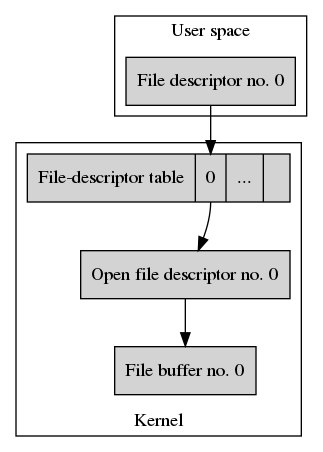
In the file system, there’s now a file name that refers to the file buffer we just opened.
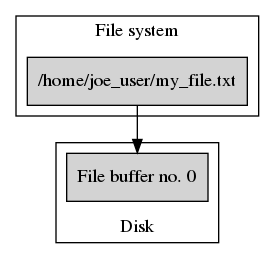
A file name that refers to a file buffer is also called hard link. There can be multiple links to the same file buffer. Or in other words, the same file buffer can be made available under different names.
Adding Hard Links
An additional name for a file is created with the command
link(). The function takes an existing file name and a new
file name. If successful, the new name refers to the existing file name’s
buffer.
Let’s create an additional hard link of the name
/home/joe_user/my_hard_link.txt.
link("/home/joe_user/my_file.txt", "/home/joe_user/my_hard_link.txt");
Our file system now looks like this.
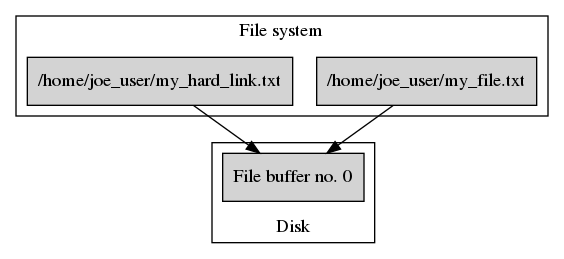
What happens if we open the new file name from within our application?
int fd1 = open("/home/joe_user/my_hard_link.txt", O_RDWR|O_CREAT, S_IRUSR|S_IWUSR|S_IRGRP);
It’s the same file buffer as before, so the result is the same as if we’d opened the file by the original name.
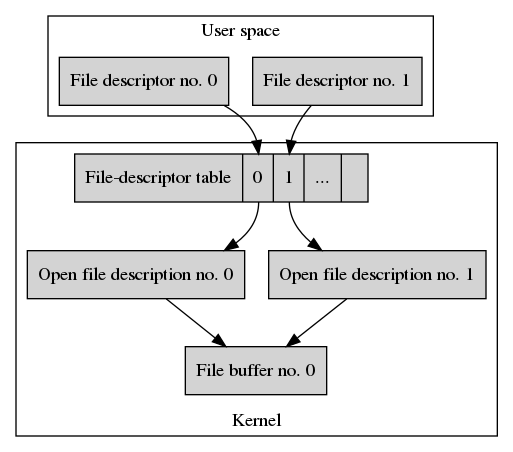
The application has opened two file descriptors, two open file descriptions, and they both refer to the same file buffer.
This is also the reason why we cannot go through all files on a file system to sum up how much space they consume on the disk. Since multiple file names can refer to the same file buffer, we could calculate a cumulative size that might be larger than the actually consumed size; maybe even larger than the maximum size of the disk.
Unlinking, Closing, and the Removal of File Buffers
A call to unlink() removes a file name from the file
system. Let’s call unlink() on both file names and the file system will
be empty.
unlink("/home/joe_user/my_file.txt");
unlink("/home/joe_user/my_hard_link.txt");
Once the final link is gone, there’s no way to create a new link to the file buffer. But the application still has these files open! How does that work?
For each file buffer, Unix maintains two counters: the link counter and the open counter.
The link counter contains the number of links refering to a file buffer.
After being created, each file starts with a link count of 1. When we
added a hard link with link() the counter went up by one. When we
removed a hard link with unlink() the counter went down by one.
The open counter countains the number of times the file buffer was opened,
or more specifically the number of open file descriptions refering to the
file buffer. When a file buffer is not opened, the open counter is 0.
Each time we opened a file buffer with open() that counter went up by one.
Only when we later close the file descriptors and the open file
descriptions get removed, the counter goes down.
When both, link counter and open counter, reach zero at the same time Unix removes the file buffer from the disk.
Let’s close both file descriptors to remove the file buffer from the disk.
close(fd0);
close(fd1);
Soft Links
Hard links have one major drawback, which is that they only work on the file system that also maintains the buffer. So if you have one partition for your computer’s operating system, an another partition for your personal data, it’s not possible to create a hard link from one file system to the other.
Unix file systems provide a solution called soft links, also called symbolic links or symlinks. Although it has a file name, a soft link is not a regular file, but a special file that stores a full file path. When an application opens the soft links, it actually opens the file at the path that is stored in the soft link. Because a file path is stored (instead of a reference to a file buffer), it’s independent from the underlying file system.
Let’s go back to the example of /home/joe_user/my_file.txt. We can create
a soft link with a call to symlink(). Like link() before,
it takes the original file’s path and the path of the symlink.
symlink("/home/joe_user/my_file.txt", "/home/joe_user/my_soft_link.txt");
With the soft link in place, the file system looks like this.
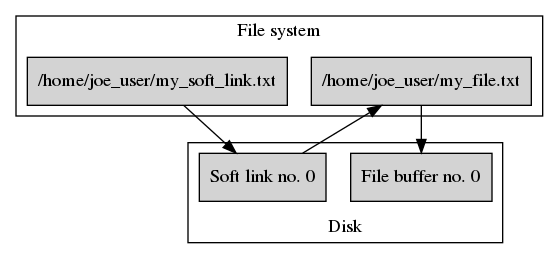
We have a file name my_file.txt, which refers to a file buffer. And we
have a file name my_soft_link.txt, which refers to the soft-link file,
which in turn refers to the original file name.
The existance of a soft link does not have any impact on the actual file, or that file buffers’s link counter. So a file can be removed, even if it is the target of a soft link. If this happens, the soft link goes stale and trying to open it returns an error.
Summary
In this blog post, we went through a tour of how hard links and soft links work on Unix, and how they affect the life time of file buffers.
- Initially each file buffer is referenced by a file name.
- The file name is called hard link.
- There can be multiple hard links ot the same file buffer.
- Opening any of a file buffer’s hard links opens the file buffer.
- A file buffer can not be opened any longer after all hard links have been removed.
- A file buffer is removed from the disk after all hard links have been removed and the file buffer is not opened by any application.
- Hard links don’t work across file-system boundaries.
- Soft links are a special type of file that reference other files by their path names.
- Opening a soft link opens the referenced file.
- Soft links can reference files on other file systems.
If you like this blog post about the basics of Unix File I/O, please subscribe to the RSS feed, follow on Twitter or share on social networks.